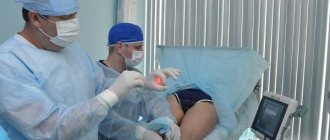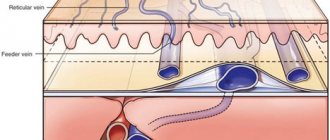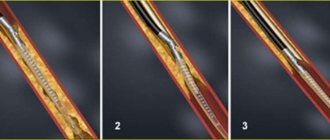- Indications and contraindications
- Operation options
- Preparation for the procedure
- The procedure for performing a miniphlebectomy
- Postoperative period
- Possible complications
- Cost of miniphlebectomy
Miniphlebectomy is a minimally invasive operation in which varicose veins are removed through punctures or small incisions.
Unlike classic phlebectomy, the mini-operation is performed on an outpatient basis under local anesthesia; it does not leave any scars. Performed by general and vascular surgeons.
Advantages of miniphlebectomy of the veins of the lower extremities:
- low morbidity;
- short duration of the operation;
- absence of scars and cicatrices;
- quick rehabilitation period.
History of the method of miniphlebectomy (microphlebectomy) of veins
The founder of the vein miniphlebectomy technique is considered to be Robert Müller, a Swiss dermatologist and phlebologist. Dr. Müller first used the miniphlebectomy method in the 1950s, as the doctor was not satisfied with the results of both scleroobliteration and surgical removal of individual venous vessels. Robert Mueller wanted an alternative method for radical vein removal, but without the side effect of large, conspicuous scars after classical operations. The miniphlebectomy method was presented by a Swiss doctor at the annual meeting of the French Society of Phlebology in the 60s of the last century after approximately 10 years of independent practical use. In subsequent years, the technology improved and developed, new manipulation techniques and more modern tools (hooks) appeared.
Professor Zoltan Varadi
The greatest contribution to this process was made by Zoltan Varadi, who seriously modified the methodology and gave it new vectors of development.
Advantages of miniphlebectomy over sclerotherapy
After the laser or radiofrequency obliteration procedure, when the source of varicose veins is eliminated, the remaining varicose veins can be removed in two ways: remove them immediately using a miniphlebectomy, or perform sclerotherapy, that is, glue the varicose veins together, leaving them behind. It would seem that sclerotherapy is less traumatic and takes less time. However, if the varicose veins are large enough, sclerotherapy has a number of negative consequences.
Firstly, sclerotic tributaries will be externally visible under the skin; after sclerotherapy they will turn into dense nodes that resolve very slowly. During this time you will need to wear compression stockings (several months). Secondly, the skin in the area of large sclerotic veins often darkens, this is called hyperpigmentation. Hyperpigmentation after sclerotherapy is not a complication, but a side effect, however, outwardly it looks very unpleasant and goes away very slowly (within 6-12 months).
It must be said that this only applies to sclerotherapy of large varicose veins; if small veins or spider veins are sclerotherapy, the effect is very good. Miniphlebectomy does not have these disadvantages, rehabilitation is very fast, knitwear is needed for only 1-1.5 weeks. The cosmetic result comes much earlier. Therefore, at present, miniphlebectomy is the optimal method for eliminating large dilated tributaries after radiofrequency or laser obliteration.
Miniphlebectomy (microphlebectomy) of veins - what is it?
Miniphlebectomy (microphlebectomy) of veins is a surgical operation to remove varicose veins using punctures or small incisions in the skin. Also, miniphlebectomy can be characterized as a radical intervention for the treatment of varicose veins with a very good cosmetic effect. Varicose veins are completely removed using miniphlebectomy.
Miniphlebectomy (microphlebectomy) of varicose veins
Small scars that form after manipulation are difficult to see with the naked eye. Using the miniphlebectomy method, almost any segments of veins located suprafascially can be removed.
Possible complications
According to reviews, complications after removal of varicose veins occur rarely, but are still possible:
- infection of puncture or incision sites;
- bleeding and development of extensive subcutaneous hematomas in the postoperative period;
- development of thrombosis, thrombophlebitis;
- the appearance of scars at the intervention site.
Small hematomas form at the site of the removed veins, which disappear after a few days. Instead, areas of skin with hyperpigmentation may remain, which last up to 2 months.
Miniphlebectomy does not prevent the appearance of new varicose veins in other places.
Types and methods of miniphlebectomy of veins
The differences in the application of the vein miniphlebectomy technique lie mainly in the use of different surgical hooks. The following hooks for miniphlebectomy are considered to be the most successful and best:
- Varadi.
- Muller.
- Eshu.
Varadi hooks for miniphlebectomy
Diagnostics before miniphlebectomy
All surgical interventions on the veins of the lower extremities are performed exclusively after a preliminary ultrasound scan of the lower extremities. We use all the capabilities of modern ultrasound scanners - from gray scale mode (B-mode) to power Doppler. We believe that a full diagnosis of varicose veins, and therefore treatment, is impossible without ultrasound angioscanning in color Doppler mapping and triplex scanning. Phlebologists at our center always do ultrasounds themselves. We also use ultrasound scanners during surgery – both during intravascular thermal interventions (EVLT, RFO) and during miniphlebectomy.
Basic principles of the vein miniphlebectomy procedure
The procedure for miniphlebectomy of varicose veins is performed in the sterile conditions of a surgical operating room using special instruments: miniphlebectomy hooks and Mosquito clamps. Varicose veins are removed through punctures and micro-incisions of the skin.
Stages of miniphlebectomy according to Varadi
The miniphlebectomy operation is quite delicate, so the experience and manual skills of the specialists performing the procedure are of great importance.
Miniphlebectomy – what is it?
Miniphlebectomy (synonym in Russian literature - microphlebectomy) according to Varadi is a modern minimally invasive method of surgical treatment of varicose veins, in which varicose saphenous veins are removed with special instruments through skin punctures of extremely small incisions. The key difference between “mini-phlebectomy” and traditional phlebectomy of the saphenous veins, for example, according to the Narat method, is the absence of incisions. There are also no stitches.
Doctor Fedorov D.A. performs miniphlebectomy according to Varadi
As a rule, skin punctures during miniphlebectomy are performed with an 18G hollow needle. Miniphlebectomy is safe and effective. The operation can be performed on an outpatient basis under local anesthesia. This method has long been successfully used by leading Russian and European phlebologists, including in our Tver Phlebology Center.
Indications for miniphlebectomy of the veins of the lower extremities
The main indication for miniphlebectomy of the veins of the lower extremities is the presence of varicose veins and nodes. Miniphlebectomy is a planned procedure indicated for varicose dilation of the tributaries of the main veins and the presence of reflux in them. Also, indications for miniphlebectomy may be complications of varicose veins:
- Recurrent thrombophlebitis.
- Bleeding from venous nodes.
- Trophic disorders associated with chronic venous insufficiency.
- Chronic venous edema.
- Skin hyperpigmentation.
- Trophic ulcer.
Indications and contraindications for the procedure
Miniphlebectomy is indicated for all types and stages of varicose veins, as well as for thrombophlebitis of the affected veins, trophic ulcers and other complications. The method is not applicable for deep-lying damaged veins. The operation is contraindicated in the presence of at least one of the following pathologies:
- decompensated form of arterial hypertension;
- pulmonary insufficiency of any degree;
- decompensated form of heart failure;
- coronary heart disease;
- bleeding disorders;
- diabetes mellitus
In addition, the operation is not recommended during pregnancy and lactation.
Relative contraindications to the intervention are systemic infectious, inflammatory, and autoimmune diseases in the acute stage. Miniphlebectomy is not recommended for rashes or inflammation of the skin in the area of intervention. After a course of therapy, surgery can be performed as planned.
Contraindications for venous miniphlebectomy
A contraindication for miniphlebectomy may be the presence of local and concomitant severe systemic pathology.
- Infection and dermatitis in the intervention area. Before surgery, it is necessary to stop the inflammatory process.
- The presence of pronounced venous and (or) lymphatic edema in the surgical area. Edema should be eliminated or reduced to reduce the likelihood of postoperative complications.
- Severe cardiovascular pathology, lung disease, uncontrolled diabetes mellitus, disorders of the blood coagulation system or immune system. Before intervention, stabilization of the underlying disease is necessary.
- Pregnancy. Miniphlebectomy is delayed until at least 12 weeks after birth. During this period, a significant portion of varixes disappear on their own.
Preoperative examination in our center before miniphlebectomy
Modern miniphlebectomy requires a standard examination for outpatient surgery under local anesthesia.
- General blood analysis.
- General urine analysis.
- Blood type and Rh factor.
- Coagulogram (analysis of the blood coagulation system).
- Blood glucose level.
- RW – test for antibodies to the causative agent of syphilis.
- Test for HIV, hepatitis B and C.
- Electrocardiogram.
- Consultation with a therapist (to identify possible concomitant pathologies).
Technique of vein miniphlebectomy procedure
Before the miniphlebectomy procedure, a detailed assessment of venous blood flow is required using duplex ultrasound scanning and the course of the operation is planned.
Mandatory ultrasound scanning of veins before miniphlebectomy
A very important aspect that affects the success of the operation is the preoperative marking of the target veins with a marker, which allows you to remove all pathological vessels in one procedure. Tumescent anesthesia, developed by Jeff Klein, is used for pain relief. A solution is used that includes low concentrations of anesthetics, which allows for more extensive interventions to be performed in a surgical setting.
Miniphlebectomy according to Varadi in Moscow
To make skin incisions at the Moscow Medical Center, 18 G needles are used. This helps minimize surgical trauma. Manipulation is carried out using special hooks. The most popular hooks among European phlebologists are Varadi, Muller, Ash, and Ramele hooks. In the practice of our center, the tools of all the authors listed above were used, but the Muller and Varady hooks showed themselves to be the best.
Miniphlebectomy technique
The hook is inserted through a skin puncture and advanced in a direction perpendicular to the course of the vein. After capturing the vessel, it is carefully removed into the wound. After which the vein is captured with a clamp. Then, using rotational movements, the varicose vein is removed. After completion of the procedure, sterile bandages are applied and compression stockings are put on.
The history of cosmetic miniphlebectomy
The miniphlebectomy technique was developed in the 50s of the 20th century by Swiss dermatologist Robert Müller
– as an alternative to classic stripping (removal of a vein using a special probe) and sclerotherapy. After ten years of practice, Muller presented his method to the medical community, and it is still successfully used by doctors around the world. As with all surgical techniques, miniphlebectomy according to Müller was supplemented and improved by the works of many famous phlebologists. In particular, the German doctor of Hungarian origin Zoltan Varadi, who modified the hooks.
Special hooks for miniphlebectomy according to Varadi
Currently, miniphlebectomy in one modification or another is mandatory for a practicing phlebologist surgeon.
Recommendations after the vein miniphlebectomy procedure
We recommend a 10 to 30 minute walk for all patients of the Innovative Phlebology Center after the miniphlebectomy procedure. This allows you to ensure the reliability of the dressings and provide better prevention of possible side effects. Most patients do not require the use of analgesics after the procedure, however, the doctor will prescribe a non-steroidal anti-inflammatory drug if pain occurs. The next day after the procedure, the patient is scheduled to see a doctor to change the bandages and have the wounds monitored by a doctor. All necessary recommendations are given.
Postoperative period
After the procedure, the patient needs to lie down for an hour, then he can go home. After miniphlebectomy of the veins, early activation is indicated, that is, walking, performing therapeutic exercises for the legs.
It is necessary to wear an aseptic bandage for 3 days. Then come to the clinic for dressing. Next, compression stockings should be worn for up to 4 weeks during the day, and removed at night.
The rehabilitation period has restrictions. For 4 weeks you cannot:
- visit a sauna, bathhouse;
- take a hot bath;
- lift weights.
If the work does not involve heavy physical labor, you can return to work 2–3 days after the operation.
Complications and side effects of vein miniphlebectomy
Using the miniphlebectomy procedure, it is possible to remove varicose veins of various locations quite completely and efficiently. As a result of the operation, the patient is left with several pinpoint scars that are subtle enough to satisfy even the most demanding patients. Possible complications in most cases are not dangerous and go away on their own. These include hyper- and hypopigmentation, local inflammation and some skin reactions caused by compression and contact with dressings. Bleeding, hematoma formation, secondary telangiectasias, lymphorrhea, and thrombophlebitis of superficial veins can occur extremely rarely. If the specialist has the proper experience, a good preoperative examination and a well-constructed treatment plan, complications and side effects of the miniphlebectomy procedure are practically excluded.
Preoperative markings before miniphlebectomy
Preoperative marking is an important point in any surgery on the veins of the lower extremities. It is especially important when performing a miniphlebectomy.
Dot marking before miniphlebectomy
We perform preoperative markings in a standing position - under ultrasound navigation. We consider the use of an ultrasound scanner for preoperative marking mandatory. The markings are applied to the skin using a special medical marker, or a solution of potassium permanganate (these dyes are harmless to health and are subsequently washed off well. Important: if there is hair in the area of the intended intervention, it should first be shaved, and the surface of the skin in the shaving area should be treated any skin antiseptic or aftershave).
Miniphlebectomy of veins in Moscow - prices for procedures
Prices in Moscow for the innovative miniphlebectomy procedure can vary significantly in individual medical centers. Sometimes the price of miniphlebectomy exceeds the cost of much more resource-intensive and technologically advanced thermoobliteration. Prices for modern miniphlebectomy surgery at the Moscow Innovative Phlebological Center have remained constant for many years and are affordable to most residents of Moscow and the Moscow region.
| Service | Treatment category | Price |
| Varadi miniphlebectomy on one lower limb (removal of varicose veins without incisions) | Category I Initial varicose veins | 20000₽ |
| II category Pronounced varicose veins | 25000₽ | |
| III category Advanced varicose veins (for thrombosis or trophic ulcer) | 30000₽ | |
| Isolated miniphlebectomy according to Varadi on one lower limb (removal of varicose veins without incisions) | At any stage of varicose veins | 39000₽ |
| Appointment with an expert phlebologist with ultrasound examination based on the results of treatment for one year | for free |
For the convenience of our patients, we work with banks that offer credit lines. Also in our center there is a flexible system of discounts and installments. Payment by Visa and Mastercard is possible. At the end of the course of treatment, the patient is given a package of documents to submit to the tax office for tax deduction.
Why is it better to perform combined phlebectomy at the Swiss University Hospital?
- In our Center for Vascular Surgery and Phlebology, miniphlebectomy is performed using proprietary methods, which have made it possible to reduce the trauma of surgical intervention, which leads to faster healing, no rehabilitation period, and improved quality of life.
- We were one of the first in the country to use minimally invasive techniques as part of combined phlebectomy in the treatment of patients with varicose veins; we own more than 40 patents for bloodless operations.
- Vascular surgeons (phlebologists) of our clinic have many years of experience in performing surgical interventions, each of our specialists is fluent in all the techniques used in our clinic. Each surgeon has performed more than 2,500 successful operations for varicose veins with analysis of long-term results. Ultrasound diagnosis of diseases of the great vessels and mapping of the features of the venous anatomy of the limb before surgery is carried out by the operating surgeons themselves using expert-class equipment at the highest professional level. All doctors are certified specialists of the highest qualification category with academic degrees.
- To perform miniphlebectomy, we use, in addition to proprietary, low-traumatic surgical instruments, disposable surgical instruments.
- We provide treatment in accordance with international standards, the quality of the services provided is assessed by international organizations that regularly visit our clinic to verify compliance with international standards.
- For each patient, we strictly determine the indications and contraindications for miniphlebectomy, based on the individual characteristics of the course of the disease, the presence and severity of concomitant pathology, physical and social activity, attitude towards one’s disease, and motivation for a good long-term result.
- We strictly and unswervingly adhere to the principles of continuity of treatment and family medicine, the principle of “open doors”, when the patient has the right to contact the operating surgeon if necessary at any time.
- We will determine the frequency of further follow-up examinations and examinations for timely detection and minimally invasive outpatient elimination of disease relapse and correction of conservative treatment.
- Together with you, we will try not only to save you from severe manifestations of the disease and its possible relapse, but also to significantly improve the quality of your life in the future.
Advantages of the miniphlebectomy method on the lower extremities
We can talk a lot and for a long time about the advantages of the modern procedure for miniphlebectomy of varicose veins. Despite its long history in European phlebological practice, the operation not only has not lost its relevance, but today it is gaining more and more new fans among phlebologists, general surgeons and vascular surgery specialists. Also, the miniphlebectomy method has found a new life in the form of the Asval technique.
Phlebologists from MIFC after a successful miniphlebectomy
The advantages of miniphlebectomy are the complete and radical elimination of varicose veins using pinpoint punctures of the skin. The anatomical features of the location of the vessels do not pose any particular difficulty for an experienced specialist who is fluent in the technique of the procedure. Modern surgical instruments, preoperative diagnostics using the latest generation equipment make the procedure one of the best ways to treat varicose veins in a good Moscow phlebological clinic.
Doctor's comment
Have you been scheduled for a miniphlebectomy and are you experiencing quite natural anxiety about the upcoming operation? In our clinic, thanks to a special technique and tactics of execution, making mini-incisions along the bikini line, we manage to achieve good and excellent cosmetic results - postoperative scars after healing after 2-3 months are almost invisible. No hospital stay is required. The operation is performed under local anesthesia with a lidocaine solution (0.1% solution 300-500 ml, sometimes 800-1000 ml), which is performed only along the path of the affected vein to be removed (injections along the varicose vein), which is quite well tolerated by the patient. The improvement and emergence of tumescent anesthesia makes it possible to effectively cope with pain and complications. Tumescent anesthesia has several advantages:
- The administration of the anesthetic is practically painless;
- The likelihood of overdose is low even when performing an extensive miniphlebectomy on both legs;
- Hydropreparation of a vein by introducing a solution into the space around the vessel;
- Compression of adjacent tissues by liquid, which reduces bleeding and prevents the formation of hematomas;
- Washing out blood accumulations when the solution flows through the incisions for several hours after surgery;
- Long-lasting analgesic effect.
We are opposed to a single template for the proposal and use of miniphlebectomy.
For each patient, we select a set of surgical intervention techniques based on the individual characteristics of the course of the disease, the presence and severity of concomitant pathology, physical and social activity, attitude towards one’s disease, and motivation for a good long-term result. Our clinic uses the most modern methods of treatment and diagnosis, including original techniques and their modifications to avoid additional tissue trauma. You will learn everything about the nature and prognosis of your illness. Together with you, we will draw up not only a detailed preoperative examination plan to exclude risk factors and contraindications to treatment, but also determine the indications for miniflectomy. Based on our experience, the principles of continuity in treatment and family medicine, the “open door” principle, when the patient has the right to contact the operating surgeon if necessary at any time. We will determine the frequency of further follow-up examinations for timely detection and minimally invasive outpatient elimination of disease relapse and correction of conservative treatment. Considering the chronic, multi-causal nature of varicose veins, the “operate and forget” principle should be considered detrimental. Together with you, we will try not only to save you from severe manifestations of the disease and its possible relapse, but also to significantly improve the quality of your life in the future. Head of the Vascular Surgery Center Girsiashvili Aleko Givievich
Miniphlebectomy of veins in Moscow - reviews from our patients
Our phlebology center has been successfully performing miniphlebectomy of the veins of the lower extremities in Moscow for more than 15 years. Here you can read reviews from patients who underwent innovative procedures at our phlebology center in Moscow.
Review of a patient from Sofrino, Moscow region about a Varadi miniphlebectomy performed in our center
Natalya Berdnikova, Sofrino, Moscow region, 06/16/2019
Dear Artem Yurievich! I would like to express my deep gratitude to you for the EVLO GSV surgery performed with Varadi miniphlebectomy on the lower leg and thigh. I am immensely glad and happy that I came to you for an appointment and treatment. After a difficult birth, a lump appeared under the knee, varicose veins, a hereditary predisposition, pronounced veins, heaviness in the legs and constant fatigue bothered me. For 28 years she was indecisive, and the disease progressed. Diagnosis: varicothrombophlebitis. I was very lucky that I was in the safe hands of such a wonderful phlebologist as Artem Yurievich Semenov. Truly, a doctor from God! My life is saved! The operation was completely painless. After finishing all the procedures, as in a fairy tale, she stood up and walked with her own legs. Artem Yuryevich, low bow to you, you again gave me lightness and freedom of movement! THANK YOU so much for being you, for your wonderful attitude towards people, for your kind heart, for your invaluable work. Natalya Berdnikova, Moscow region, Sofrino, June 16, 2021
Review of a patient from Moscow about a Varadi miniphlebectomy performed in our center
Savchenko Svetlana, Moscow, 11.11.2019
Dear Dmitry Anatolyevich! Thank you very much for your attentive attitude, high professionalism and respect for us, the patients!
Savchenko Svetlana, Moscow, 11.11.2019
Why can’t all dilated veins in the leg be treated with a laser?
The fact is that methods such as laser and radiofrequency obliteration are used to treat large venous trunks - the great and small saphenous veins (GSV and SSV), as well as their largest and most permanent tributaries (anterolateral tributary). These large vessels, although called subcutaneous, are most often located deep in the subcutaneous fat and under the superficial fascia and are not always visible on the leg. They are the cause of the development of varicose veins, and what the patient sees on his legs are varicose dilated tributaries of the main trunks. These tributaries are often highly tortuous or develop into large varicose veins. By the way, in advanced stages of varicose veins, sections of the main trunks can also wriggle and turn into nodes.
Laser and radio waves are used to close the main venous trunks that have a straight course.
It is very difficult to insert a laser light guide or radiofrequency catheter into tortuous tributaries of superficial veins or varicose veins. In addition, as a rule, such veins are located close to the skin, which can lead to burns. Therefore, to eliminate these veins, the method of miniphlebectomy or sclerotherapy is used.
Results of treatment of patients using venous miniphlebectomy. Photos before and after treatment.
Specialists at the Moscow Phlebology Center have extensive experience in performing innovative phlebological procedures, including miniphlebectomy of the veins of the lower extremities. We work only according to the best European standards. This helps to always get good results from miniphlebectomy treatment within the walls of our center in Moscow.
The result of patient treatment using Varadi miniphlebectomy in our center
Photos before and after Varadi miniphlebectomy on the right lower limb
The result of treatment using the Varadi miniphlebectomy method in our
Photos before and after Varadi miniphlebectomy on the right lower limb
Treatment in Moscow
Treatment of blood vessel diseases in Moscow can be done at the Yusupov Hospital. The hospital is equipped with modern equipment, various operations are carried out using modern techniques, minimally invasive operations. The hospital's rehabilitation center offers post-operative recovery. The hospital provides a massage therapist, performs physiotherapeutic procedures, creates an individual diet, and gives recommendations on indications and contraindications after surgery. You can make an appointment with a doctor by calling the hospital.
Frequently asked questions from patients on the Internet about vein miniphlebectomy in Moscow
Miniphlebectomy of varicose veins, what is the price in Moscow?
Good miniphlebectomy of varicose veins in Moscow is performed in modern phlebological centers. Prices for the miniphlebectomy procedure are most often determined by the commercial policy of a particular medical institution. In the vast majority of cases, the miniphlebectomy operation complements the endovenous thermal obliteration procedure. At the Moscow City Phlebology Center, the cost of a modern miniphlebectomy procedure for varicose veins on one lower limb will range from 20 to 39 thousand rubles, depending on the volume of intervention. You can get more detailed information about prices for the center’s services by calling: 8 (495) 565 35 09, or on our website page:.
Where is endovenous laser coagulation of veins with miniphlebectomy performed, how much does treatment cost in Moscow?
Modern endovenous laser coagulation of varicose veins with miniphlebectomy is carried out in city phlebological centers in Moscow. The cost of treatment using endovenous laser coagulation with miniphlebectomy is determined after ultrasound duplex scanning and consultation with a phlebologist. The price of the procedure for endovenous laser coagulation with miniphlebectomy at the Moscow City Phlebological Center within one venous pool ranges from 69,500 rubles. You can get more detailed information about prices for the center’s services by calling: 8, or on our website page:.
What is a miniphlebectomy of the veins of the lower extremities?
Miniphlebectomy of the veins of the lower extremities is a modern surgical procedure used for the radical treatment of varicose veins. The technique involves removing the veins of the lower extremities through skin punctures. Miniphlebectomy of veins has one of the best combinations of radicality and good postoperative cosmetic effect.
What is better, miniphlebectomy or vein sclerosis?
Miniphlebectomy and sclerotherapy (scleroobliteration) of venous vessels are good modern methods for treating varicose veins. Both miniphlebectomy and scleroobliteration are successfully used to remove varicose veins by the best phlebologists in Moscow. Each of these methods has its own specific advantages. Only a specialist can tell you which technique: miniphlebectomy or slerobliteration is right for you after an in-person consultation and ultrasound scan of the venous system.
When will residual veins resolve after miniphlebectomy?
To accurately answer your question about when the veins will resolve after a miniphlebectomy, you need to have more detailed information regarding your particular case. Ideally, you need a face-to-face consultation with a specialist. During the miniphlebectomy procedure, varicose veins are almost completely removed. Individual vessels remaining after miniphlebectomy may collapse on their own within one to six months. In some and quite rare cases, additional scleroobliteration procedures may be required.
How does the procedure work?
Before performing a miniphlebectomy, the patient undergoes standard diagnostics, which includes:
- general clinical blood and urine tests;
- ECG;
- coagulogram (test for blood clotting);
- blood tests, smears from the genital tract for sexually transmitted and other infections.
On the eve of the operation, the doctor palpates the affected vein for thrombosis and compactions, and immediately before the intervention makes markings with a special marker: he places dots in the places where the vein comes as close as possible to the skin. During the intervention, incisions or punctures will be made at these points. Another stage of preparation is ultrasound of the veins to position perforating vessels with incompetent functioning.
Important: since a miniphlebectomy does not use general anesthesia, there is no need to follow a diet or abstain from food. However, on the eve of the intervention you should not eat foods that can cause intestinal upset. This is not a matter of contraindications, but a component of patient comfort during surgery.
Before removing veins, the doctor anesthetizes the marked areas using a paravasal method - injecting an anesthetic into the tissue next to the vessel being removed. It takes no more than 3 minutes for the anesthetic to take effect. After this, the doctor begins to remove the veins according to the standard algorithm:
- Creating punctures or cuts along previously applied markers. To perform them, a scalpel with a narrow blade or an 18G needle is used. The width of the incision is 1-2 mm.
- Introduction of a phlebectomy hook into punctures. It is carefully placed under the vein and lifted, removing it from the puncture. Vein ligation (ligation) is not required during traction. The blood flow is interrupted using clamps.
- Vein pulling. The surgeon uses surgical spatulas to separate the vessel from the surrounding tissue, but in most cases the blood tube is easily pulled out. Repeat the procedure on all markers, gradually highlighting the vessel along its entire length.
- Vein removal. The doctor cuts off the resulting loop of vein with surgical scissors. A surgical clamp is left at the end of the vein heading into the upper thigh. The lower one is released and squeezed for a few seconds to stop the bleeding. So they move from loop to loop, removing the entire vessel.
After removing the vein, the limb is treated with an antiseptic, and the edges of the punctures or incisions are glued together with a surgical plaster. The procedure from the injection of anesthetic to the complete removal of the vein and application of bandages takes from 20 to 40 minutes.
While the patient is on the table, he is put on compression stockings and transported to the ward. There his condition is monitored for 20 minutes to an hour, after which he is sent home. After a few days, a re-examination is carried out to ensure that there are no complications.
Stages of modern miniphlebectomy according to Varadi
- Preparation of the surgical field. Carried out in advance - at home. Involves shaving or depilation of the skin followed by treatment with a skin antiseptic solution.
- Preoperative markings. It is carried out immediately before the operation by the operating surgeon-phlebologist. Marking is carried out using ultrasound navigation and visual control.
- Treatment of the surgical field with a skin antiseptic solution. It is carried out by the operating surgeon-phlebologist immediately at the beginning of the operation. We prefer to use clear hypoallergenic skin antiseptics. If you are allergic, be sure to notify your doctor in advance.
- Local anesthesia. Miniphlebectomy is a minor operation, very well tolerated under local anesthesia. No anesthesia or spinal anesthesia is required. To relieve pain during miniphlebectomy surgery, various local anesthetics, usually of low concentration, can be used. The surgeon injects the anesthetic only along the diseased vein. Anesthesia can be created either using a standard 10-20 ml syringe and a thin needle, or using a special operating infiltration pump (we prefer to use a pump). A method of local anesthesia using a solution of local anesthetic with a low concentration of an anesthetic drug is called infiltration anesthesia. This is what is used for miniphlebectomy. As the local anesthetic is administered, the surgical area of interest is numbed. This process is almost instantaneous and persists for some time after the operation is completed. We use only modern safe anesthetics recommended by the Russian Association of Phlebologists. However, in case of an allergic reaction, there is always an anti-shock first aid kit in the operating room.
- Removal of varicose saphenous veins is actually a “miniphlebectomy” according to Varady, Müller, Esch. The veins are removed by experienced clinic specialists through small punctures of the skin using special surgical instruments (hooks) made of “medical” stainless steel or titanium.
Punctures during miniphlebectomy are almost invisible
- The use of innovative surgical instruments allows us to reduce surgical trauma to a minimum. A few months after a correctly performed miniphlebectomy, the scars will be barely noticeable, and will subsequently resolve completely. Please note that some patients may have problematic skin prone to the formation of hypertrophic or keloid scars. In this case, the scars will be more noticeable, but this has nothing to do with the features of miniphlebectomy as a method. Patients should understand that painfully altered veins removed during surgery will not return, but this will in no way negatively affect the venous outflow from the diseased limb. On the contrary, eliminating the so-called reflux (backflow of blood through diseased veins) will improve the condition of the affected limb. It should also be borne in mind that throughout the patient’s life, varicose veins may appear in another place, and such a relapse is not related to the treatment performed. If necessary, these altered veins can also be removed.
- Considering that miniphlebectomy is an outpatient operation that does not require hospitalization or anesthesia, you will not have to take sick leave or change your lifestyle.
- Application of aseptic dressings and compression. Skin punctures made by the surgeon during surgery do not require suturing. They heal superbly on their own without leaving any rough scars. Upon completion of the operation, the wounds are closed with sterile aseptic dressings, after which pre-selected modern compression stockings are put on. The next day the dressing is done. Miniphlebectomy surgery involves wearing medical compression stockings in the postoperative period. The duration of wearing knitwear is determined by the attending physician.
Preparation for miniphlebectomy and features of the operation
Preparation for miniphlebectomy does not require any specific actions on the part of the patient. Before treatment, you must undergo the standard minimum and some specific studies, obtain written permission for treatment from the therapist and come to the clinic at the appointed time.
Before the operation:
- General and biochemical blood tests, urine tests;
- Fluorography and ECG;
- Screening for infections (HIV, hepatitis, syphilis);
- Coagulogram.
To clarify the nature of the damage to the veins, ultrasound, functional tests, and palpation are used. The listed studies can be completed before hospitalization in the clinic at the place of residence, and upon admission to the hospital, the results should be taken with you.
Since the Varadi operation is performed under local anesthesia, there is no need for significant restrictions on the eve of treatment. The patient can eat and drink whenever he wants, but, of course, it is better not to overdo it and not overload his body with excess food or liquid.
The operation site is treated in the usual way, the hair is shaved first, but very carefully so as not to cause irritation or dermatitis. Immediately before the manipulation, the surgeon applies markings to the affected area of the body, identifying puncture points by palpating the veins or using ultrasound. A local anesthetic (lidocaine, novocaine) is injected using thin needles into the tissue surrounding the venous vessels.
The number of punctures and the distance between them are determined by the characteristics of the veins in a particular patient, their elasticity, the thickness of the subcutaneous tissue, the extent of vascular damage, and the nature of their branching. It is more convenient to make punctures where the perforating vessels depart or the veins themselves are divided into smaller branches. The first puncture is made in the place where the vein will be pulled out, the second - where the skin will stretch when the vessel section is removed, these punctures are made sequentially in the required quantity. The section of the affected vein is removed using a special thin hook.
If the vein fragment being removed is thicker than 3 mm, then some specialists practice linear incisions with a thin scalpel, which then restore their integrity without scarring. If it is necessary to excise a large varicose node, the latter can be pre-filled with a sclerosing agent in order to reduce its size, which will make the process of removing the node less traumatic.
Removing small dilated veins on the feet, hands, and under the skin of the face requires great care and painstaking work by the surgeon, on which the final aesthetic result of the treatment will depend.
After the procedure is completed, skin punctures are sealed with a special adhesive plaster, which ensures good and rapid healing without scars. Elastic bandaging or putting on compression hosiery of the 2nd compression class immediately after completion of the operation is considered mandatory. In places where large nodes have been removed, special compression rollers can be placed to prevent the formation of hematomas.
The miniphlebectomy operation takes on average 30-40 minutes, but can be longer, depending on the expected number of veins to be removed. Immediately after the intervention, the patient usually remains under observation for about 2-3 hours. In most cases, you are allowed to leave the clinic on the same day; this is safe, provided you follow all the phlebologist’s recommendations.
Cost of miniphlebectomy
The price of miniphlebectomy surgery is indicated in the “Prices” section on our website. However, you can clarify the final cost of treatment by consulting a phlebologist with an ultrasound scan of the veins of the lower extremities. More difficult cases often require combination treatment. Didn't find the information you need on the site? Our call center operators will be happy to help you by calling (812) 320-70-00.
Advantages of miniphlebectomy in Moscow with Dr. D.A. Fedorov
- Dmitry Anatolyevich works in a well-equipped surgical department. You will not need to be hospitalized, but the operation will be performed under the same conditions as major surgery.
- An anesthesiologist-resuscitator is always present at the clinic. You most likely will not need one, but it is important to understand that the anesthesiologist is available and ready to help you.
- Only modern equipment and medications are used.
- All therapeutic and diagnostic actions comply with the official recommendations of the Association of Phlebologists of Russia.
- With a miniphlebectomy, varicose (diseased) veins are removed from the body. The procedure is performed simultaneously and does not require any “finishing”. Unlike other procedures for the treatment of varicose veins (in particular, sclerotherapy), the positive effect of miniphlebectomy is immediate and occurs immediately upon completion of the operation. If other subcutaneous varicose veins appear during life, they can also be removed on an outpatient basis.
- Low morbidity. The wounds inflicted by a surgeon during a miniphlebectomy are very small and heal well without suturing (and therefore without removing sutures!). There are no rough scars left. The operation performed by our phlebologists does not require you to change your lifestyle. The risk of complications during miniphlebectomy is minimal.
- Outpatient procedure. Modern miniphlebectomy is an outpatient procedure that does not require hospitalization and anesthesia, as well as spinal anesthesia. The need to take sick leave is discussed with the attending physician, but as a rule, this is not required.
- Cosmetic. Considering that the surgical punctures are extremely small and are made taking into account the skin stretch lines, the result is an excellent cosmetic effect.
- By contacting Dmitry Anatolyevich Fedorov at the Innovative Phlebological Center, you can be sure that you will receive modern and qualified medical care.










